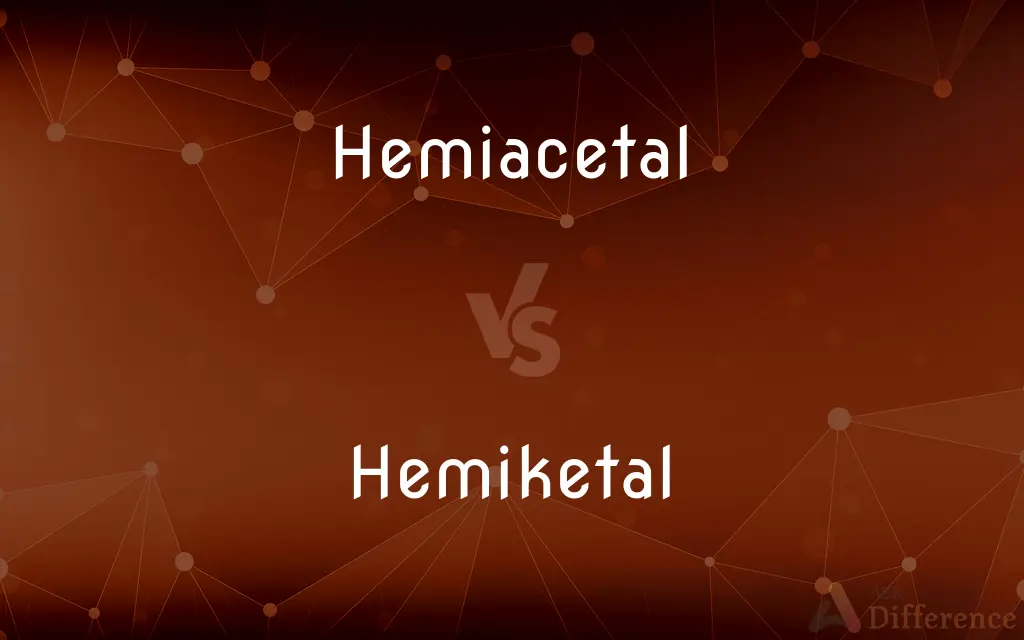Hemiacetal vs. Hemiketal — What's the Difference?
By Maham Liaqat & Fiza Rafique — Updated on March 16, 2024
Hemiacetals form when an aldehyde reacts with an alcohol, featuring a carbon atom bonded to an -OH and an -OR group, while hemiketals result from the reaction of a ketone with an alcohol, with the central carbon bonded to two -OR groups.

Difference Between Hemiacetal and Hemiketal
Table of Contents
ADVERTISEMENT
Key Differences
The formation of both hemiacetals and hemiketals involves a nucleophilic addition reaction, where the alcohol's oxygen acts as a nucleophile and attacks the carbon of the aldehyde or ketone. This reaction is reversible, and under certain conditions, can lead to the formation of acetals or ketals, respectively, which are more stable than their hemi- counterparts.
In the context of sugars, the formation of hemiacetals and hemiketals is vital for creating cyclic structures. For example, glucose exists primarily in its cyclic form, which is a hemiacetal, within biological systems. The difference between hemiacetals and hemiketals thus lies not just in their formation but also in their significance in organic and biochemical pathways.
The stability of hemiacetals and hemiketals can vary, with both types of compounds often existing in equilibrium with their open-chain forms in solution. This equilibrium plays a crucial role in the reactivity and functionality of carbohydrates and other molecules containing these functional groups.
Hemiacetals are intermediary compounds in carbohydrate chemistry, forming through the reaction of an aldehyde and an alcohol. On the other hand, hemiketals are similar compounds but originate from ketones rather than aldehydes.
Comparison Chart
Origin Compound
Aldehyde
Ketone
ADVERTISEMENT
Alcohol Reaction
Reacts with one alcohol molecule
Reacts with two alcohol molecules
Functional Groups
Contains an -OH and an -OR group on the carbon
Contains two -OR groups on the carbon
Occurrence
Common in carbohydrate chemistry
Less commonly discussed, but present in ketoses
Stability
Variable, often in equilibrium with aldehyde
Variable, often in equilibrium with ketone
Significance
Crucial for cyclic structure in sugars
Important in biochemical pathways
Compare with Definitions
Hemiacetal
Features a carbon bonded to an -OH and an -OR group.
The hemiacetal functional group is a key feature in many sugars.
Hemiketal
Equilibrium with ketone in solution.
Hemiketals can revert to their ketone form under certain conditions.
Hemiacetal
Common in sugar chemistry, forming cyclic molecules.
The formation of hemiacetals is essential for the ring structure of many carbohydrates.
Hemiketal
Forms through the reaction of ketones, less common than hemiacetals.
Hemiketals play a role in specific biochemical pathways.
Hemiacetal
An intermediate compound formed from an aldehyde and alcohol.
Glucose forms a hemiacetal in its cyclic structure.
Hemiketal
Characterized by a central carbon bonded to two -OR groups.
Hemiketal structures are involved in the chemistry of ketoses.
Hemiacetal
Can exist in equilibrium with the open-chain form.
In aqueous solution, hemiacetals can revert to their aldehyde form.
Hemiketal
A compound formed from the reaction of a ketone with alcohols.
Fructose can form a hemiketal in its cyclic form.
Hemiacetal
Important for the structure and reactivity of sugars.
Hemiacetal formation influences the properties of aldoses.
Hemiketal
Involved in the cyclic structures of some sugars.
The cyclic form of fructose involves a hemiketal formation.
Hemiacetal
A hemiacetal or a hemiketal have the general formula R1R2C(OH)OR, where R1 or R2 is hydrogen or an organic substituent. They generally result from the addition of an alcohol to an aldehyde or a ketone, although the latter are sometimes called hemiketals.
Hemiketal
(chemistry) any hemiacetal derived from a ketone
Hemiacetal
(organic chemistry) Any of a class of compounds of general formula R1R2C(OH)OR' (where R' is not H and R1 or R2 is often hydrogen).
Hemiacetal
An organic compound usually formed as an intermediate product in the preparation of acetals from aldehydes or ketones
Common Curiosities
Can hemiacetals and hemiketals convert to more stable forms?
Yes, under certain conditions, they can convert to acetals and ketals, respectively, which are more stable due to the absence of the -OH group.
How do hemiacetals and hemiketals form?
They form through a nucleophilic addition reaction between an aldehyde or ketone and an alcohol molecule(s).
What is the key difference between a hemiacetal and a hemiketal?
Hemiacetals are derived from aldehydes and contain an -OH and an -OR group, while hemiketals originate from ketones and feature two -OR groups.
What is an example of a hemiacetal in nature?
Glucose, in its cyclic form, is an example of a naturally occurring hemiacetal.
What happens to hemiacetals and hemiketals in water?
In water, they can exist in equilibrium with their open-chain form, shifting between cyclic and linear structures.
Can hemiacetals and hemiketals be found in all carbohydrates?
They are found in many, but not all, carbohydrates, especially those that can form cyclic structures, like glucose and fructose.
Why are hemiacetals and hemiketals important in sugar chemistry?
They are crucial for the formation of cyclic structures in sugars, which affects the properties and reactivity of these carbohydrates.
Are hemiacetals and hemiketals stable compounds?
Their stability varies, and they often exist in equilibrium with their open-chain forms in solution, especially in aqueous environments.
What role do hemiacetals and hemiketals play in biochemistry?
They are involved in the structure and function of various biochemical molecules, especially carbohydrates and glycosides.
How does the structure of hemiacetals and hemiketals differ?
The structural difference lies in the number and type of groups attached to the central carbon; hemiacetals have an -OH and an -OR group, while hemiketals have two -OR groups.
Share Your Discovery

Previous Comparison
Crown vs. Garland
Next Comparison
Indica vs. SativaAuthor Spotlight
Written by
Maham LiaqatCo-written by
Fiza RafiqueFiza Rafique is a skilled content writer at AskDifference.com, where she meticulously refines and enhances written pieces. Drawing from her vast editorial expertise, Fiza ensures clarity, accuracy, and precision in every article. Passionate about language, she continually seeks to elevate the quality of content for readers worldwide.















































